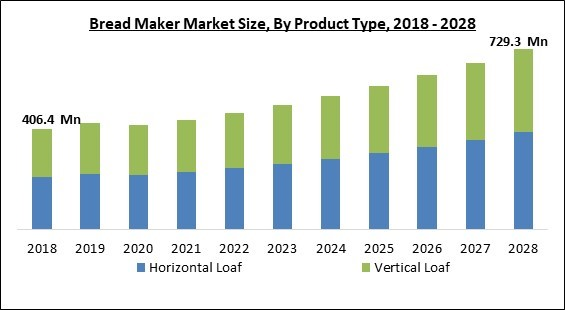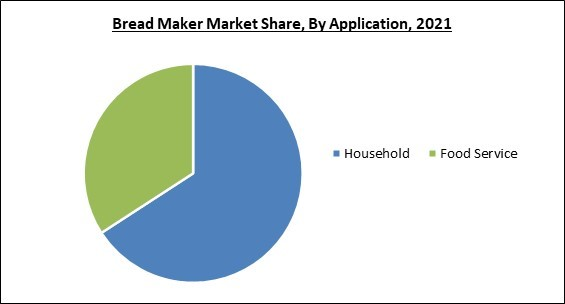The Global Bread Maker Market size is expected to reach $729.3 million by 2028, rising at a market growth of 7.6% CAGR during the forecast period.
Small electrical appliances called breadmakers are used to prepare a variety of breads and loaves from raw materials. People frequently use them for household purposes, and some specialty food service companies use them for baking their own bread. These bread machines are used by householders to save on going out to buy bakery goods, while food service providers utilize them to provide their patrons with freshly baked bread.

An easy-to-use electric counter appliance called a bread maker is used to speed up the process of mixing and kneading dough. It helps to produce freshly baked, preservative-free bread. It is generally accessible in a variety of shapes and sizes, and it may be used to make a variety of loaves of bread, from whole-grain loaves to sweet, buttered brioche. Presently, a number of businesses provide high-end, user-friendly, and adaptable models for creating jam as well as pizza dough. To improve the user's entire baking experience, some versions contain ingredient dispensers that automatically add almonds, yeast, sultanas, and chocolate, as well as other extras.
Ingredients are weighed into the bread pan in the proper order (often liquids first, followed by solid ingredients) and the pan is then inserted in the breadmaker to produce a loaf of bread. The instant yeast used by breadmakers needs to come in contact with water to activate, thus the sequence of the components is crucial. Until the program begins, the yeast and water must be kept apart. A loaf of bread is produced by the machine in a number of hours. Prior to cooking, the components are rested and heated to the ideal temperature.
The mixture is next stirred with a paddle to form a dough. The dough is then cooked after perfect temperature control proofing. The pan is removed from the breadmaker once the bread has baked, leaving a tiny hole or indentation from the rod that the paddle is attached to. The resulting loaf's shape is frequently regarded as strange; many early breadmakers produced loaves that were square or cylindrical, vertically oriented, and notably dissimilar from commercial loaves; more current models, on the other hand, typically have horizontal pans that look more conventional. Some bread makers use two paddles to create a two-pound loaf in the typical rectangle shape. Even the lid of one of the Zojirushi models contains a heating element to brown the crust.

The market research report covers the analysis of key stakeholders of the market. Key companies profiled in the report include Panasonic Corporation, Samsung Electronics Co., Ltd. (Samsung Group), Sony Corporation, Spectrum Brands Holdings, Inc., Newell Brands, Inc., Koninklijke Philips N.V., Breville Group Limited, Cuisinart Corporation (Conair Corporation), Sana Products Ltd. and Siroca, Inc.
Small electrical appliances called breadmakers are used to prepare a variety of breads and loaves from raw materials. People frequently use them for household purposes, and some specialty food service companies use them for baking their own bread. These bread machines are used by householders to save on going out to buy bakery goods, while food service providers utilize them to provide their patrons with freshly baked bread.

An easy-to-use electric counter appliance called a bread maker is used to speed up the process of mixing and kneading dough. It helps to produce freshly baked, preservative-free bread. It is generally accessible in a variety of shapes and sizes, and it may be used to make a variety of loaves of bread, from whole-grain loaves to sweet, buttered brioche. Presently, a number of businesses provide high-end, user-friendly, and adaptable models for creating jam as well as pizza dough. To improve the user's entire baking experience, some versions contain ingredient dispensers that automatically add almonds, yeast, sultanas, and chocolate, as well as other extras.
Ingredients are weighed into the bread pan in the proper order (often liquids first, followed by solid ingredients) and the pan is then inserted in the breadmaker to produce a loaf of bread. The instant yeast used by breadmakers needs to come in contact with water to activate, thus the sequence of the components is crucial. Until the program begins, the yeast and water must be kept apart. A loaf of bread is produced by the machine in a number of hours. Prior to cooking, the components are rested and heated to the ideal temperature.
The mixture is next stirred with a paddle to form a dough. The dough is then cooked after perfect temperature control proofing. The pan is removed from the breadmaker once the bread has baked, leaving a tiny hole or indentation from the rod that the paddle is attached to. The resulting loaf's shape is frequently regarded as strange; many early breadmakers produced loaves that were square or cylindrical, vertically oriented, and notably dissimilar from commercial loaves; more current models, on the other hand, typically have horizontal pans that look more conventional. Some bread makers use two paddles to create a two-pound loaf in the typical rectangle shape. Even the lid of one of the Zojirushi models contains a heating element to brown the crust.
COVID-19 Impact Analysis
The COVID-19 pandemic severely impacted the bread maker market. Because of the unforeseen COVID-19 pandemic outbreak, the majority of the world's countries have implemented lockdowns or curfews, which have significantly hampered people's quality of life, health, and ability to engage in outdoor recreation. As a result, the bread maker industry's expansion has been slightly hampered. Sales of goods like air conditioners, TVs, refrigerators, and other large appliances would be impacted by any delay in returning to regular living. The need for small and large appliances has positively impacted the general trends in consumer choice for performance, simplification, health hygiene, as well as international commerce during the COVID-19 pandemic.Market Growth Factors
An Increasing Number of Technological Advancements in The Bread Maker Technology
The demand for bread machines throughout the world is being driven by technologically sophisticated features including gluten-free settings, LCD display, paid bake mode, adjustable loaf size, automatic shut-off, etc. Therefore, the growth of the food and beverage industry and advances in digital technology are significant drivers of the bread machine market.Rising Efforts of Market Players Operating in The Sector
One of the major factors that are driving the growth of the bread maker market is the increasing number of market players boosting their efforts in order to bring new breakthroughs and sophisticated products across the market. Bread machine manufacturers are focusing their efforts on the creation of groundbreaking new products in order to attract the attention of consumers. This, in turn, is anticipated to assist the manufacturers in bolstering their competitive advantage and, as a result, increasing their market share.Marketing Restraining Factor
Complexities and Challenges in Using the Equipment
Some machines can only run the program that was previously set on them. Users will need to enter the appropriate settings into the machine so that the bread will have the desired texture. Individuals don't intend for the end result to be sticky or rock solid. In addition to this, people will need to set the timer. If they get the am and pm mixed up, they will either have issues or they will not have any bread at all. In addition, checking to see that the timer and temperature are set appropriately for the current season is also essential, as most machines are temperature sensitive
Product Type Outlook
Based on the Product Type, the Bread Maker Market is bifurcated into Horizontal Loaf and Vertical Loaf. In 2021, the horizontal segment acquired the largest revenue share of the bread maker market. The growth of the segment is increasing at a very rapid pace due to increased spending in the food business. In addition, the surge in the growth of the segment can also be ascribed to the increasing support from governmental institutions.Application Outlook
By Application, the Bread Maker Market is divided into Food Service and Households. In 2021, the foodservice segment registered a significant revenue share of the bread maker market. The growth of the segment is increasing at a very rapid pace as a result of the growing number of food service facilities around the world. Due to the increasing popularity of making a variety of bread in order to meet the increasing demands. of customers throughout the market, the adoption of bread makers is significantly increasing in the foodservice sector.Distribution Channel Outlook
On the basis of Distribution Channel, the Bread Maker Market is segregated into Specialty Stores, Supermarkets/Hypermarkets, E-commerce, and Others. In 2021, the Supermarkets/Hypermarkets segment witnessed the highest revenue share of the bread maker market. The growth of the segment is increasing at an exponential rate due to the growing number of big supermarkets as well as hypermarkets throughout the world.Regional Outlook
Region-Wise, the Bread Maker Market is analyzed across North America, Europe, Asia-Pacific, and LAMEA. In 2021, North America accounted for the largest revenue share of the bread maker market. Due to the rising demand from working families, numerous kinds of automatic bread makers have seen greater growth in North America. A number of significant macroeconomic variables, like the rise in per-capita income and the adoption of the internet, have a significant impact on the expansion of the bread maker market throughout the region.The market research report covers the analysis of key stakeholders of the market. Key companies profiled in the report include Panasonic Corporation, Samsung Electronics Co., Ltd. (Samsung Group), Sony Corporation, Spectrum Brands Holdings, Inc., Newell Brands, Inc., Koninklijke Philips N.V., Breville Group Limited, Cuisinart Corporation (Conair Corporation), Sana Products Ltd. and Siroca, Inc.
Scope of the Study
By Product Type
- Horizontal Loaf
- Vertical Loaf
By Application
- Household
- Food Service
By Distribution Channel
- Supermarkets/Hypermarkets
- Specialty Stores
- E-commerce
- Others
By Geography
- North America
- US
- Canada
- Mexico
- Rest of North America
- Europe
- Germany
- UK
- France
- Russia
- Spain
- Italy
- Rest of Europe
- Asia Pacific
- China
- Japan
- India
- South Korea
- Singapore
- Malaysia
- Rest of Asia Pacific
- LAMEA
- Brazil
- Argentina
- UAE
- Saudi Arabia
- South Africa
- Nigeria
- Rest of LAMEA
Key Market Players
List of Companies Profiled in the Report:
- Panasonic Corporation
- Samsung Electronics Co., Ltd. (Samsung Group)
- Sony Corporation
- Spectrum Brands Holdings, Inc.
- Newell Brands, Inc.
- Koninklijke Philips N.V.
- Breville Group Limited
- Cuisinart Corporation (Conair Corporation)
- Sana Products Ltd.
- Siroca, Inc.
Unique Offerings
- Exhaustive coverage
- The highest number of market tables and figures
- Subscription-based model available
- Guaranteed best price
- Assured post sales research support with 10% customization free
Table of Contents
Chapter 1. Market Scope & Methodology
Chapter 2. Market Overview
Chapter 3. Global Bread Maker Market by Product Type
Chapter 4. Global Bread Maker Market by Application
Chapter 5. Global Bread Maker Market by Distribution Channel
Chapter 6. Global Bread Maker Market by Region
Chapter 7. Company Profiles
Table Information
| Report Attribute | Details |
|---|---|
| No. of Pages | 194 |
| Published | October 2022 |
| Forecast Period | 2021 - 2028 |
| Estimated Market Value ( USD | $ 442 Million |
| Forecasted Market Value ( USD | $ 729.3 Million |
| Compound Annual Growth Rate | 7.6% |
| Regions Covered | Global |
| No. of Companies Mentioned | 10 |








